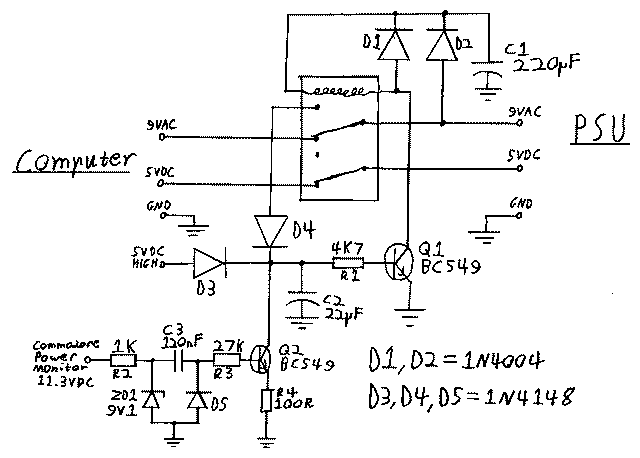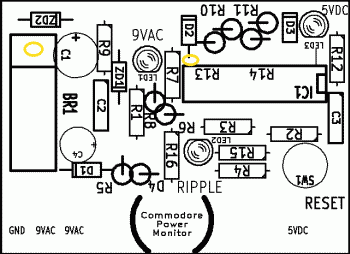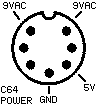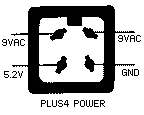
Computer Nerd Kev |
Home|About|Projects|Links |
Projects > C= Monitor > Relay |
DIY Relay Power Cut-Off for Commodore Power Monitor |
This circuit allows a relay to be connected to the 5VDC High output of the Commodore Power Monitor to cut off the computer's supply voltage if it becomes too high, immediately preventing damage. I do not sell these due to the assembly time required in wiring the power connectors.
Note that the standard output for this circuit from the Power Monitor only switches off the computer in the case that the 5VDC line voltage becomes too high, not if it becomes too low. This is because Low 5VDC voltage is less likely to cause damage.
With the Commodore power monitor circuit disconnected, this circuit will still allow power to the computer, though of course it will be unable to protect it.
This circuit is designed to be as safe and reliable as possible in the event that the 5VDC regulation of the Commodore external power supply failes. To this end it is powered by the 9VAC supply rather than the 5VDC supply, because in the case that the 5VDC regulation fails it may not be reasonable to assume that this same supply will be able to maintain an appropriate voltage for the relay after the computer is switched off.
The circuit also switches both the 5VDC and the 9VAC supplies off even though the 5VDC supply is the only one with the reported fault. As well as being generally elegant electronically, this ensures that no part of the computer or attached devices may be stressed due to the incorrect voltage combination of 9VAC but no 5VDC.
These versions of the circuit save components by providing fewer of the above mentioned safeguards.

Power for the relay is taken from the 9VAC line from the Commodore external power supply and Half-Wave rectified by D2, then filtered by C1 to create an unregulated 12VDC supply for the relay. D1 protects Q1 from voltage spikes from the Relay coil when it is turned off.
While the relay is off, power is connected to the Commodore computer, hence the power switch on the computer works as normal. When the 5VDC voltage is detected as being High, the 5VDC High output from the Power Monitor board in the computer goes from low to high (with a high level of ~12V, and a low level of close to 0V). This turns on Q1 via current limiting resistor R1, and Q1 in turn connects one end of the relay coil to Ground, allowing it to turn on.
When the relay turns on, both the 5VDC and 9VAC lines are disconnected from the computer. When the switching action is completed, the 9VAC supply is connected to D4, which rectifies the supply. C2 now filters this supply so that Q1, and in turn the relay, is kept on even though there is no signal from the Power Monitor. While the initial relay switching action is taking place, C2 maintains power to Q1 to ensure that the coil remains energised. C2 and R1 are configured to power Q1 for over 40mS, which allows for a maximum relay switching time of 20mS, plus the period of the 9VAC waveform on a 50Hz supply.
The circuit involving Q2 disables the relay cut-off for about 5mS when the computer is first turned on. This is to prevent false triggers while the reference voltages in the Power Monitor stabilise. The input is taken from the Power Monitor's rectified 9VAC power supply, when it rises from 0V after the computer is tuned on, C3 generates a positive pulse at R3, turning on Q2, which keeps C2 discharged below the voltage required for Q1 to turn on the relay. ZD1 regulates the input voltage to prevent power supply ripple or other noise from turning on Q2 when the computer is already on.
The parts are not special, and should be easily available from electronics suppliers (with the possible exception of the DIN plug and socket, one could wire the circuit directly into the Commodore power cable if desired)
The relay circuit connects to the Power Monitor's 5VDC HIGH output at pin 7 of Op-Amp IC1, and its 11.3VDC unregulated supply at the positive Bridge Rectifier terminal (closest the rear of the board).
This diagram shows the locations for the wire connections, which should be made to the bottom (solder side) of the board with care that the wires do not contact any other nearby connections:

Pinouts for the power plugs of the various Commodore computers are shown below. All are as viewed looking towards the plug.
 |
 |
 |